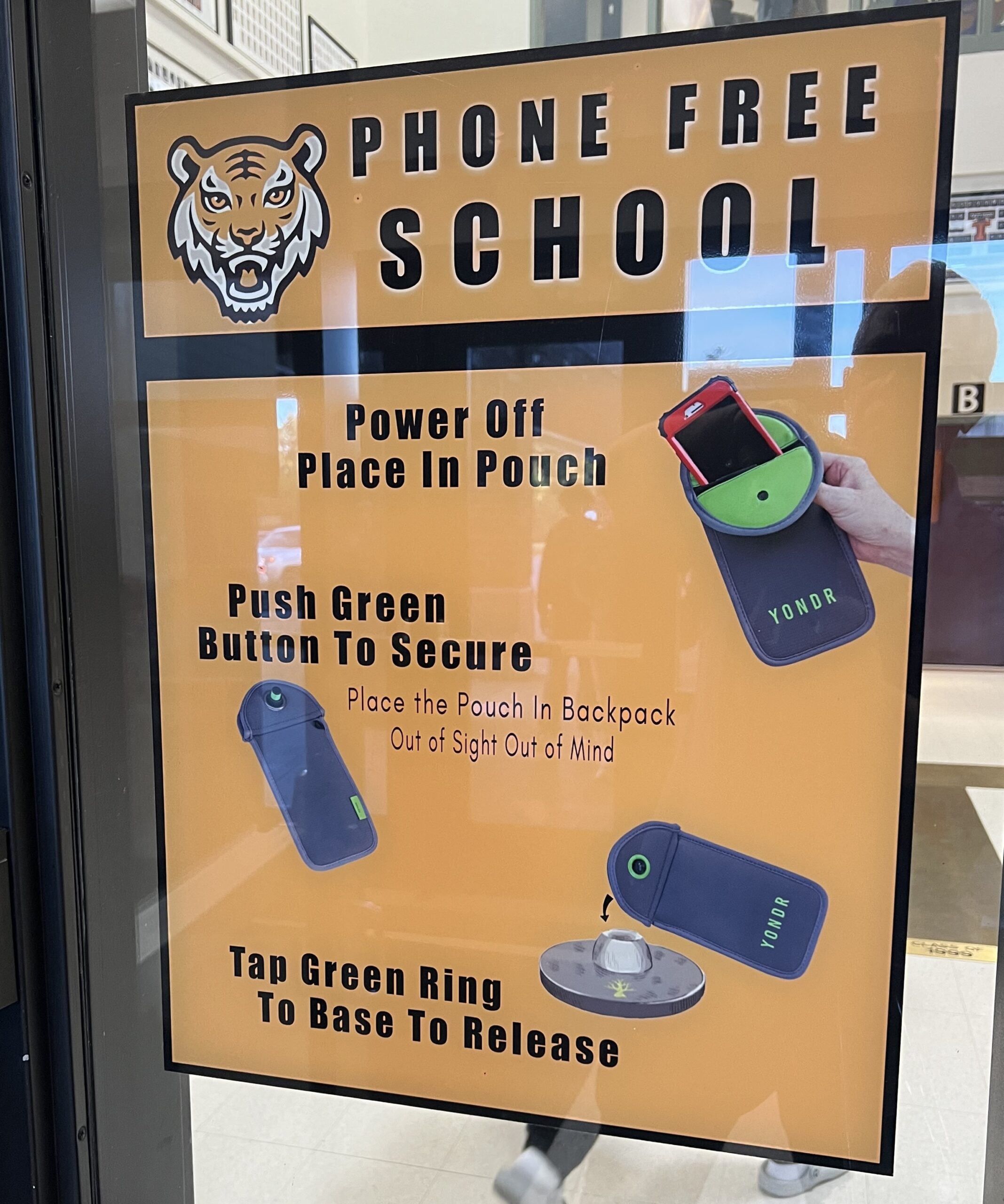
By NATALIE PATE/Oregon Public Broadcasting
SALEM — Oregon students may soon be prevented from using cellphones and other personal electronic devices at school.
Oregon House Bill 2251, which House representatives passed Tuesday on a 36-21 vote, requires school districts to ban student cellphone use during the school day.
 The bill received bipartisan support on the House education committee, with Rep. Emily McIntire, R-Eagle Point, as the lone dissenting vote. But it only passed the House on Tuesday after a lively half-hour floor debate that showed a split among Republicans. The bill now heads to the Senate side.
The bill received bipartisan support on the House education committee, with Rep. Emily McIntire, R-Eagle Point, as the lone dissenting vote. But it only passed the House on Tuesday after a lively half-hour floor debate that showed a split among Republicans. The bill now heads to the Senate side.
The debate among state lawmakers echoes what’s been heard in school districts nationwide: Phones in school are a problem. We need to do something about it. But what? And who gets to decide?
In 2023, Florida became the first state to ban public school students from using cellphones in class. More states have since either passed similar legislation or considered it, with a total of at least 19 states enacting bans by February, according to Education Week.
The national conversation largely blew up after the publication of “The Anxious Generation: How the Great Rewiring of Childhood is Causing an Epidemic of Mental Illness” by Jonathan Haidt. Policymakers across the country — including Oregon representatives this week — have cited it as their reason for acting now.
Rep. Kim Wallan, R-Medford, is a chief sponsor of Oregon’s bill. She explained that under HB 2551, local school boards would still have a say on how the ban is implemented.
The bill requires that each district has a policy, and there have to be consequences when students break the rule. But “how you do your bell-to-bell ban is up to you,” she told lawmakers on the House floor Tuesday. “How you enforce it is up to you as a district.”
Wallan said Oregon has some of the poorest-performing schools in the country, and she doesn’t see a lot of legislation aimed at addressing that. But this could be a pivotal step.
“None of the states that have enacted legislation, and none of the districts that I have heard about who have enforced or introduced a policy have reversed course,” she said. “That tells me a lot about the need for this bill. It tells me a lot for the need to get the phones out of the kids’ hands during school so they can learn.”
Democrats in favor pointed to the benefits of removing cell phones — such as examples of fewer fights, less bullying and better attendance in schools with bans. They also stressed that something like this at the state level could give local school boards more political power and protection to implement such policies, which they may have resisted passing before due to parent pushback.
Bill sponsor Wallan wasn’t the only Republican speaking in favor of the bill.
Rep. Christine Drazan, R-Canby, pointed out that no one was arguing that phones make kids do better in school. The point of tension between the two sides was largely over who should get to decide whether schools need to ban phones. Drazan shared testimony that resonated with her to show why she felt it was time lawmakers stepped in.
“ ‘I remember the smoking lounge in my high school. I’m that old’,” Drazan read from the testimony. “Me too,” she added. “I’m that old. There used to be a smoking spot at my high school. Shocking. Today, we would never in a million years create a space for underage, minor smoking on our high school campuses. And yet, when I was growing up, that was common.”
She continued sharing the testimony, saying that, in time, those lounges were shut down.
“We made the appropriate assessment that the impact on students’ health, the co-dependence of the school enabling youth smoking and nicotine addiction, far outweighed any reason to offer this privilege to students,” Drazan read. “Let’s not be complicit with the addiction that our students have to social media. Let’s no longer turn a blind eye to the serious damage that cellphone content is wreaking on our youth. Let’s help our students thrive and our schools climb out of the academic and mental health holes that we are in.
“We cannot continue doing the same thing and expecting a different outcome,” she read. “It just makes no sense.”
Still, there remained a split, largely among Republicans, on whether to support the bill.
Some argued this was an overstep on the state’s part to control a decision that should be made by local school boards — and in many cases, already has been — and that passing such a bill would create a “slippery slope” to more state control.
“If I was president of the world, no child would have a cell phone, an iPad, or anything else until they’re 18. Just that simple,” said Rep. Boomer Wright, R-Coos Bay.
But then he said he reflected on ideals of America’s founding fathers, concluding: “Government should never do what the people can do themselves.”
Some school districts have already restricted handheld devices, including Oregon’s largest district. Portland Public Schools enacted a districtwide policy in January. The Lincoln County School District leaves it up to individual schools — only the middle and high schools in Lincoln City have a strict ban. The rest of the district relies on teachers to enforce no-phone-in-the-classrooms rules — with varying results.
Rep. David Gomberg, R-Otis, voted with the majority.
Under Portland’s policy, all students — regardless of grade — must turn off their phones, smartwatches and other personal electronic devices during school hours, including lunch periods. Some exceptions exist, particularly for students with disabilities who need personal devices to communicate or learn effectively. Cellphones can also be used for approved academic activities or programs.
Rep. Virgle Osborne, R-Roseburg, argued it was hypocritical to restrict students’ cellphone use when lawmakers are allowing what he argues to be inappropriate materials to be circulated in school libraries.
Rep. Annessa Hartman, D-Gladstone, was the only Democrat who spoke on the floor against the bill. She argued that school board leaders and district administrators are in the best position to make such decisions for their individual communities. She also voiced the concern many parents have about being able to reach their children during the school day in the event of an emergency.
“I am a mom of two daughters. I work full-time. To me, having the ability to communicate with them throughout the day if needed is really important,” she said. “There have been cellphones in schools for 20 years. And to me, instead of banning them or taking it from the state and putting in a top-down, we need to be teaching our kids how to properly use cellphones.”
Oregon Gov. Tina Kotek said last summer that she would support a statewide approach, and the Oregon Department of Education released recommended guidelines in October.
Responding to the House debate and vote on Tuesday, Kotek said HB 2551 was the right thing to do, adding, “I’d like to sign that bill.”
- This story originally appeared April 15, 2025 on Oregon Public Broadcasting.





















Retired teacher here. I hate restricting liberties for kids but I have to agree with this one. We have to put a whole bunch of rule in place to create a less disruptive environment. The Supreme Court has ruled that we can limit clothing, as an example, if it is disruptive. In the classroom we fight to keep the attention of students and we compete with the most engaging distraction ever invented. We lose. Learning suffers.
(FYI, I served as technology director in two school districts and put more technology in front of more kids than you can imagine. I was the school board president of Oregon Virtual Academy, an online K-12, for four years. I know about technology in schools.)